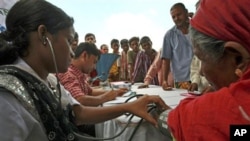United Nations agencies say millions of health workers around the world are at risk of becoming infected with HIV and tuberculosis while treating the sick. New guidelines developed by the International Labor Organization, World Health Organization and UNAIDS aim to protect health workers from these occupational hazards.
There are more than 60 million health workers throughout the world whose job it is to care for the sick. They play an important role during epidemics in delivering services to the public.
Sophia Kisting is Director of the International Labor Organization's Global Program on HIV/AIDS and the World of Work. While health workers provide vital services to others, she says very often their own conditions of work, occupational safety and health are overlooked.
"We find that health workers are on the frontline in providing prevention and treatment and care for people living with HIV and TB throughout the world," says Kisting. "They are at risk of occupational exposure to HIV and TB and now in the context of MDR and XDR [multi-drug resistant and Extreme Drug Resistant] TB, it is even a much higher risk. But, so often, they, themselves, lack adequate access to protection or to treatment."
The new guidelines are aimed at overcoming these concerns. They are based on international consultations and an assessment of current practices in 21 country-based studies.
The 14-point guidelines are inter-related and can be effectively implemented as one package. They ensure priority access for health workers and their families to prevention and treatment services for HIV and TB.
Other provisions include strengthening occupational health services for the entire health workforce, the provision of free HIV and TB treatment for health workers, policies to prevent discrimination against health workers with HIV and TB, and adequate compensation for health workers who become sick on the job.
Technical Officer in WHO's Occupational and Environmental Health Division, Susan Wilburn, says health workers are exposed to many illnesses, such as HIV, TB, hepatitis and Avian influenza.
"We know that there are at least 1,000 new infections, work-related infections with HIV every year globally as a result of health worker exposures," Wilburn says. "Those are estimates of the burden of disease. And among health workers who are infected with hepatitis, 40 percent of those infections are work-related infections."
Many countries suffer critical shortages of health workers. The problem is most acute in Africa. The United Nations notes Africa has 11 percent of the global population and 25 percent of the global health burden, with only three percent of the health workforce.
New HIV, TB Guidelines Designed to Protect Health Workers











